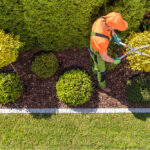How To Know If You Need To Remove A Dead Tree In Minnesota
Identifying whether a tree is dead or living can sometimes be a very tricky task – especially in the winter time when every tree can look dead. While it is possible, yet sometimes difficult, to revive some sick or dying trees it is impossible to bring a dead tree back to life. There are many reasons that you should remove a dead tree in Minnesota which we will touch on in this post.
But how exactly can you tell if a tree is dead, sick, or healthy? Here are a few signs that can help you determine exactly this question and what steps to take after.
Things to check for on a dead tree
The first thing that you need to do is inspect the actual tree in question. There are a few visual signs that will help you out as well as some tests you can perform on the tree itself.
Fungus Growth
Take a look around the tree’s trunk and base of the trunk. Do you see any fungus growing? Fungus is an initial sign that the tree could be dead. If you spot fungus on the trunk this is often an indication that the internals of the tree trunk are actually rotted out and anything beyond the living fungus is dead.
Tree Trunk Damage
Keeping your focus on the actual tree trunk itself, give it a good visual inspection. Look for cracks that are running vertically along it. If the trunk has severe damage this increases the likelihood that the tree is in bad health.
Check to see if the tree has bark. As trees age bark will fall off of the trunk and if healthy grow back to replace the old stuff. If a tree isn’t as healthy you will see areas, large or small, on the trunk that are just smooth areas of wood with no bark covering it.
Check for Bare Branches
Take a look at the trees’ branches. If they’re abnormally bare during a time when they shouldn’t be – such as Spring or Summer – there’s a good chance the tree is too far gone to save. Sometimes branches on only half of a tree are bare and the other side are full.
This would signal that the tree is diseased only on one side in which case could cause a tree to become lopsided and fall due to the weight. If the tree is deciduous check to see if the leaves cling onto the branches in the winter instead of falling off as this is another sign the tree may be dead.
Check for Damaged Roots
While performing a check of the roots to see if they are damaged is not easy there are some factors that could help you guess if the roots could be damaged.
An initial sign that a trees’ roots may be damaged is if the tree appears to be leaning to one side or the other. This could mean the tree’s roots are not strong enough to keep it directly upright. If the roots are damaged or weak, epicormic shoots could be present at the base of the trunk.
These are sprouts that can pop up and mean that the tree is under severe pressure underneath the ground. There are some other factors that could affect a trees roots both natural and man-made. Things like excavation projects, new construction, shallow root systems, exposure to new extreme elements, or loosened soil compaction.
Check to see if any of those are present near the tree area.
Perform Scratch or Break Test
Performing a scratch test is an easy way to tell the health of a tree. Use a small knife to scratch the outside of one of the tree’s branches. If the inside is green and moist the tree is healthy.
Try this on a few more branches in different areas of the tree. If they are all green and moist the tree is in good shape. You can also perform a break test which is the same thing except instead of scratching the outside you can attempt to break the branches to check the inside.
How to tell if a tree is dead in the winter
Determining if a tree is dead in the winter is a little bit more difficult because dormant trees can look just like a dead tree. One thing you can look for however is if the tree has buds on the branches. Even in the winter time a tree should show signs of buds. You can also perform the scratch test here as well for further determination.
Why are dead trees an issue?
Aside from being unattractive, a dead tree can be a serious risk to not only humans but to the surrounding natural environment as well. Let’s walk through why it is dangerous to ignore a dead tree.
Disease/insects can spread to other trees
There are many causes of a dead tree but if the tree in question is dead because of disease this can cause serious harm to surrounding trees. Disease as well as insect infested trees can easily spread to nearby trees and exert their power on others resulting in the same fate as the original tree.
Attracts insects/pests
Along with disease spreading to other trees, dead trees tend to attract a lot of unwanted insects and pests. Termites and rats for example love to congregate to a dead tree. And if the tree is close to your house they’ll eventually make your home their own home.
Dead branches falling
A dead tree means dead branches. And dead branches mean weak branches that can randomly fall. Branches can range in size and if a large branch snaps off and falls it can cause serious harm to any pedestrian that happens to be standing below it.
Can fall on hazards
Dead branches can fall on hazardous areas but so too can the entire tree itself. If a tree is extremely fragile it can topple over entirely. Trees that are especially close to things like power lines, cars, houses, or pedestrian areas can wreak havoc and could end up being extremely expensive to remedy. It’s best to take care of them before this happens.
How to determine if I should remove a dead tree
More often than not you should remove a dead tree, always. Here’s how to determine if the tree is ok to leave be or if it needs to go.
If it’s in a remote area the tree can be left alone: Dead trees in remote areas can serve as a place for various species of woodpeckers and other wildlife to nest.
If 50% of the tree is damaged, you should remove a dead tree: At this point it is probably too far along in the process to be able to revive it.
Near hazardous conditions: If a dead tree is near any sort of hazardous condition it should immediately remove a dead tree due to safety concerns
If it could benefit nearby trees’ health: Determine if by removing the tree it will also benefit the health of the surrounding trees in the area. It can often help stymie disease from spreading to the other trees around it.
What to do if you have a dead tree
If you determine that a tree needs to be removed please don’t hesitate to contact us for our expert advice. Our certified arborists will do a thorough inspection to confirm or deny that the tree is indeed dead and discuss your next options as well as give any recommendations.
We are aware that trees have great sentimental, aesthetic and environmental value. Our number one priority is to treat and save a tree whenever it is possible. However, when we give you an estimate, we will point out the visible and reasonable dangers as well as offer you the best ways to solve your problem.
If you feel that you need an expert opinion, our quote form takes only seconds to complete. We will contact you about your problem and help you make the best possible decision to get your dead tree removed as quickly as possible!









